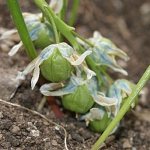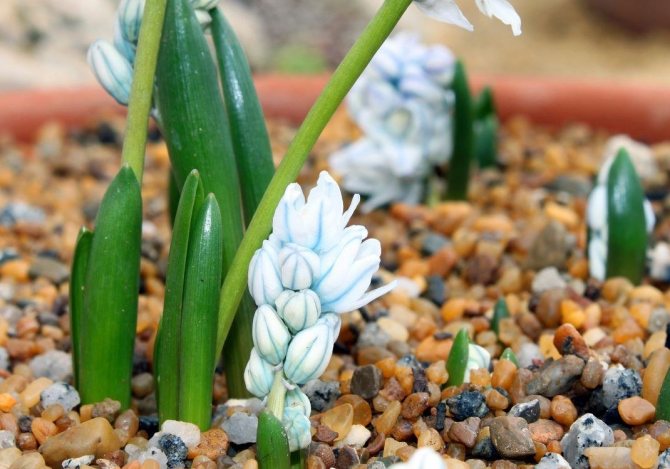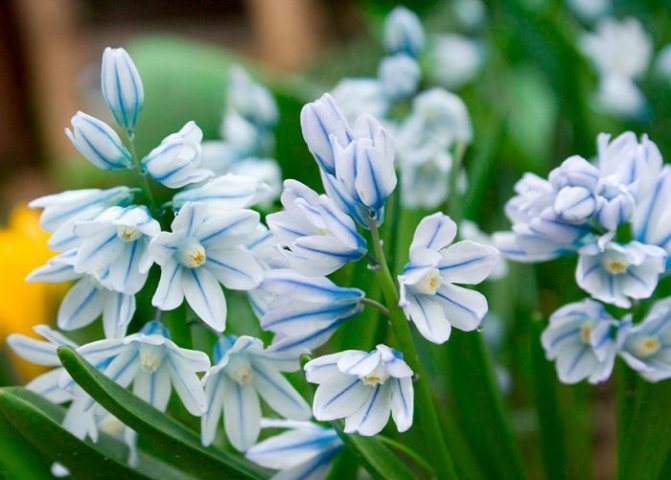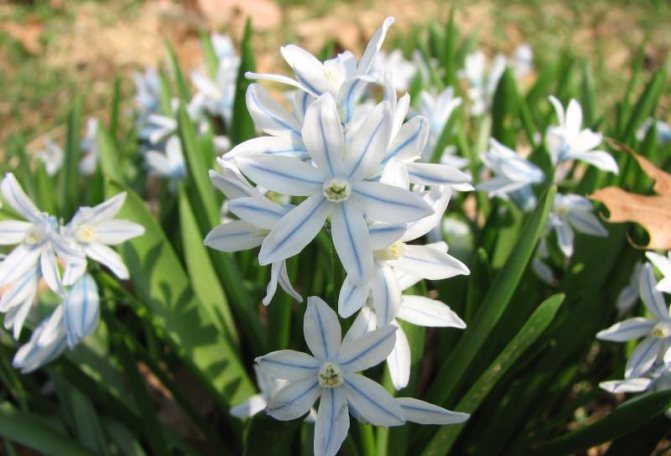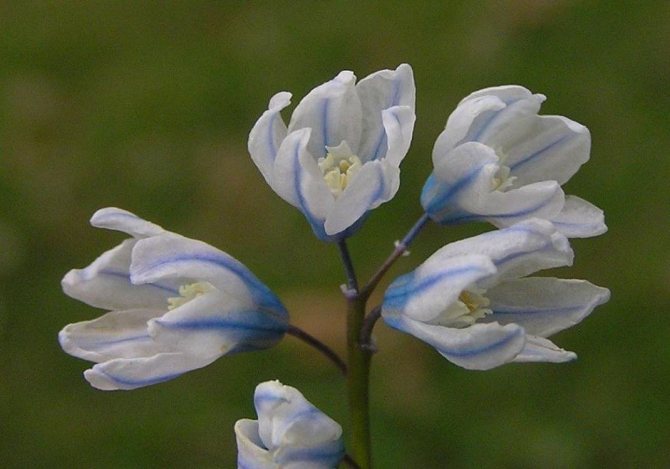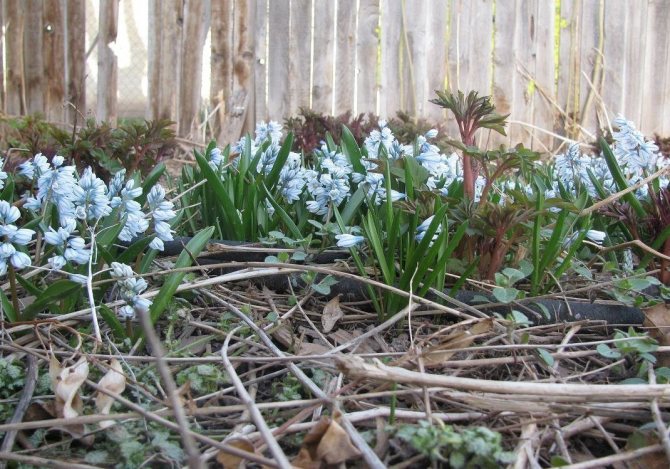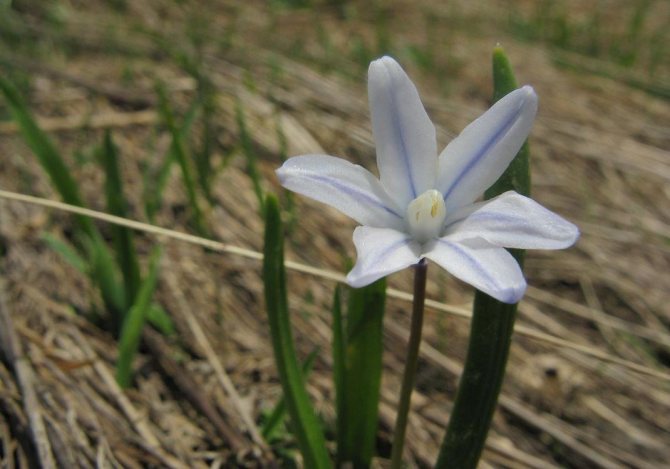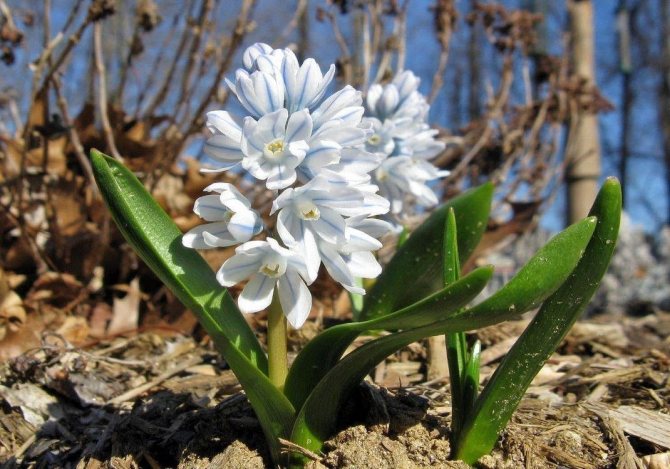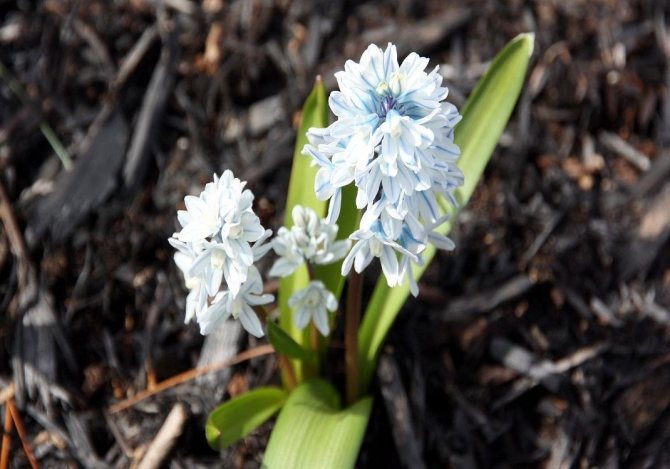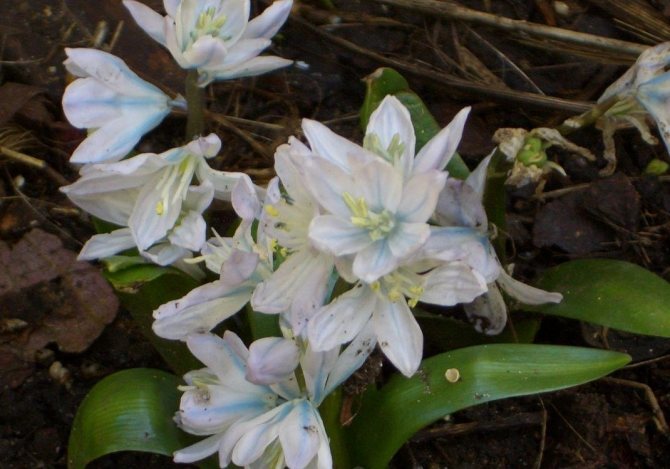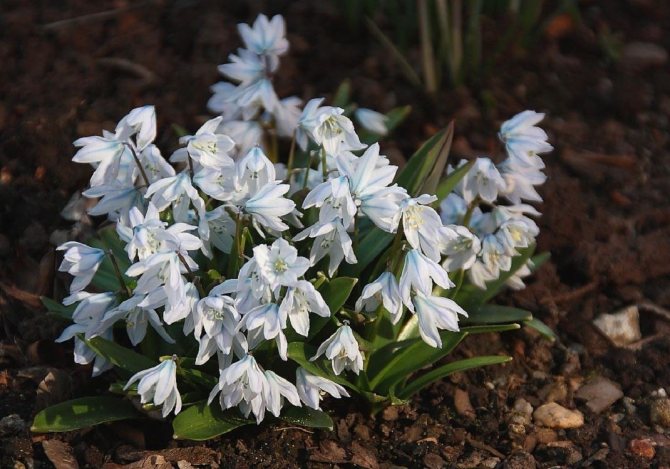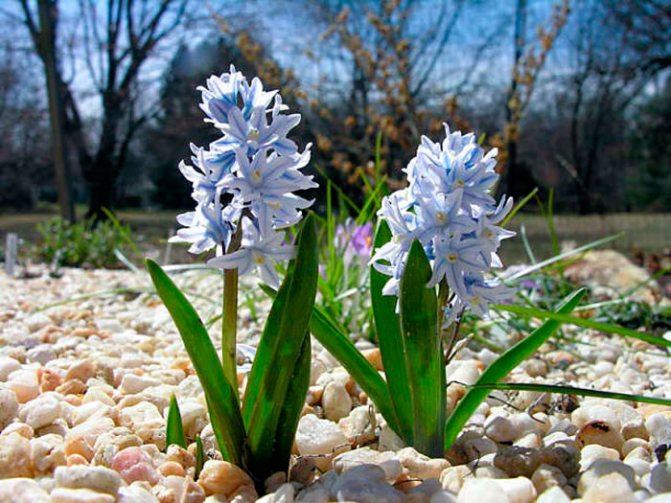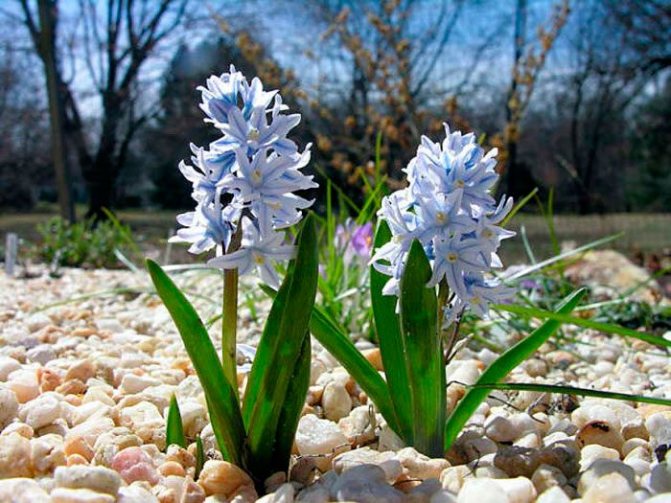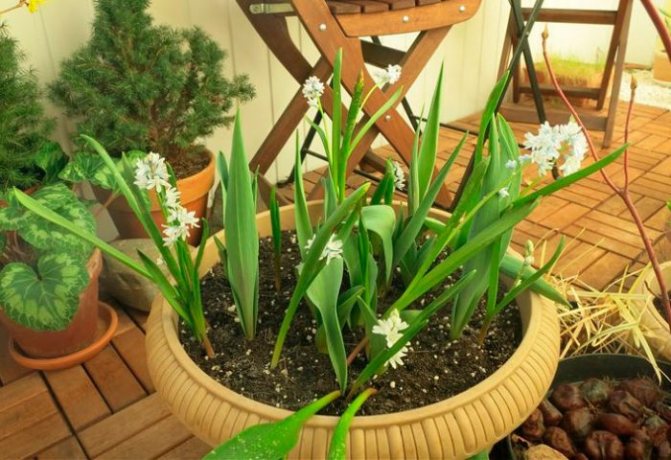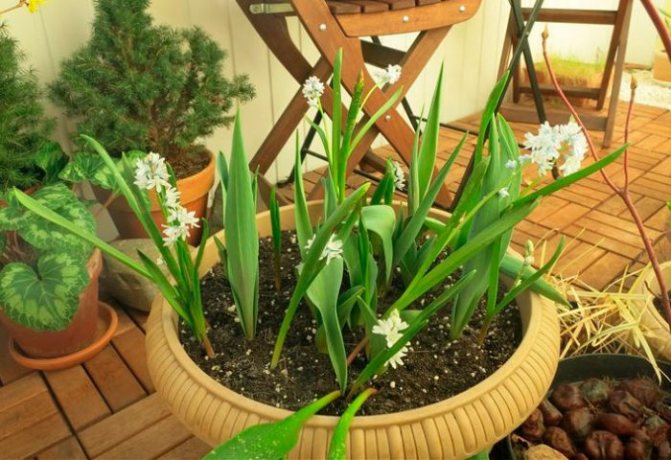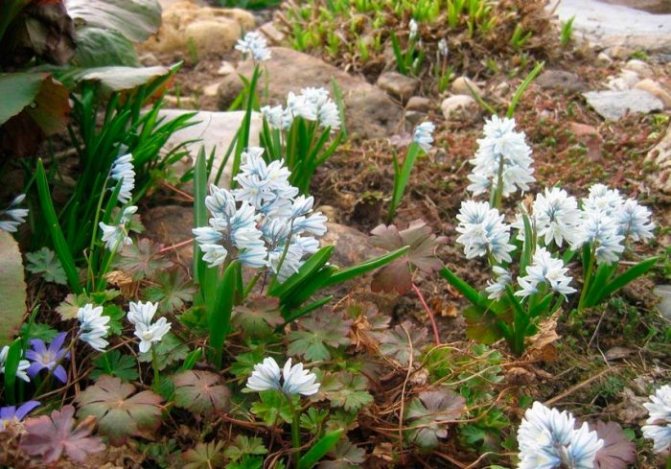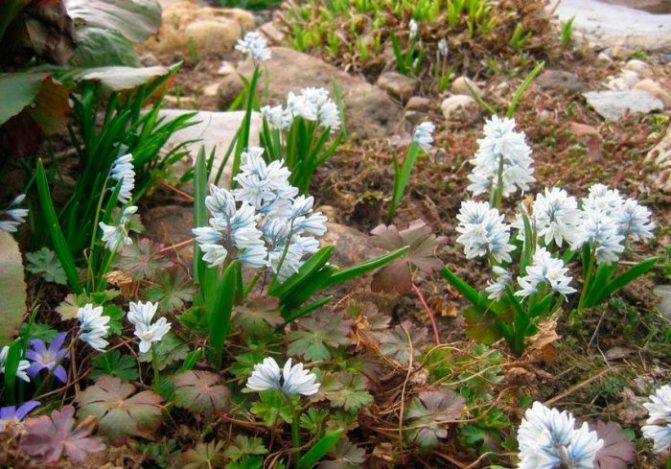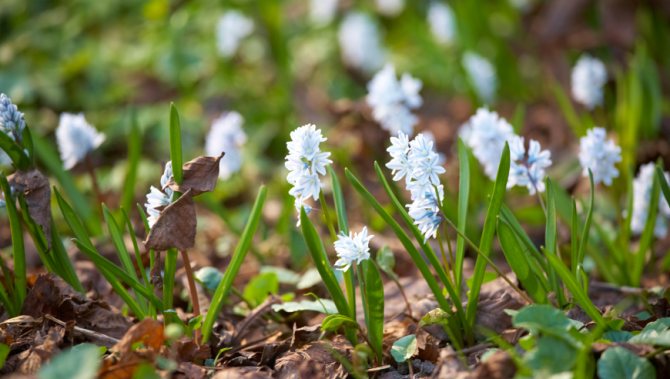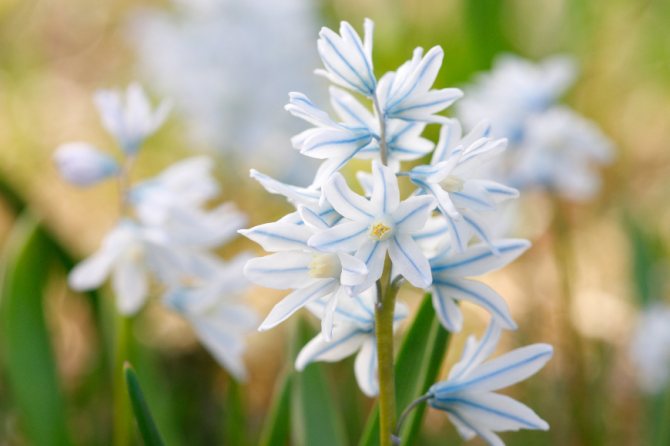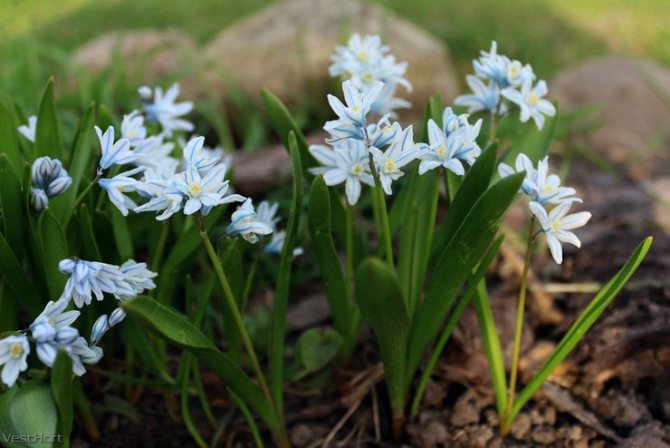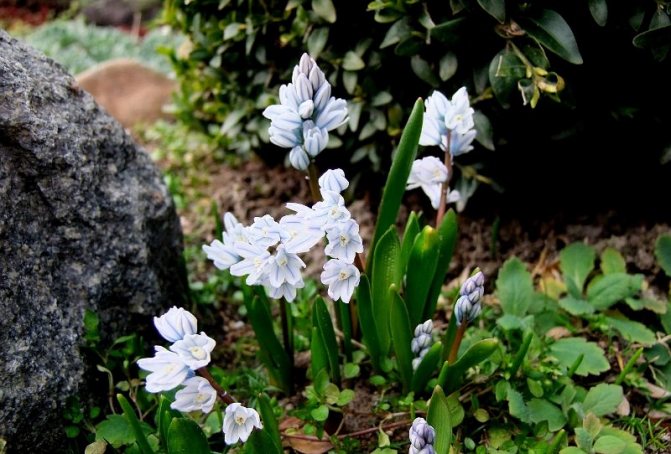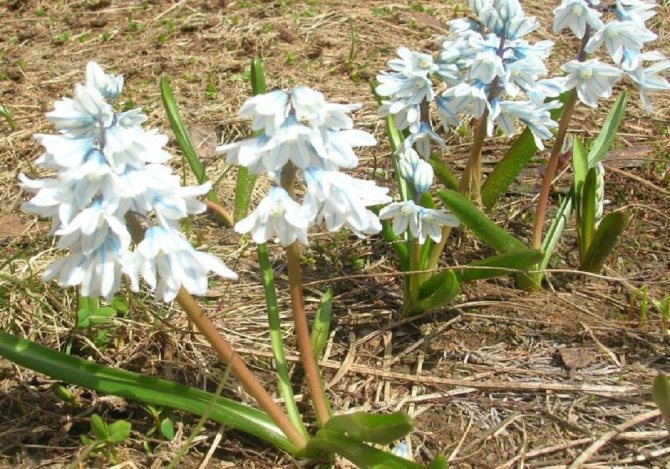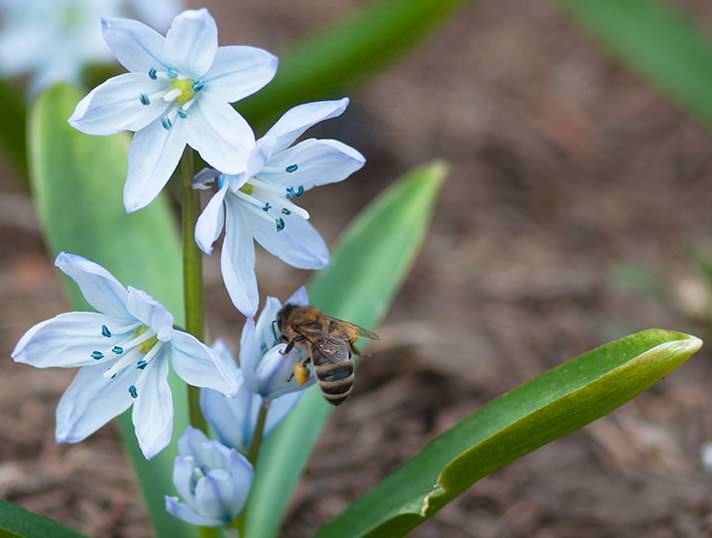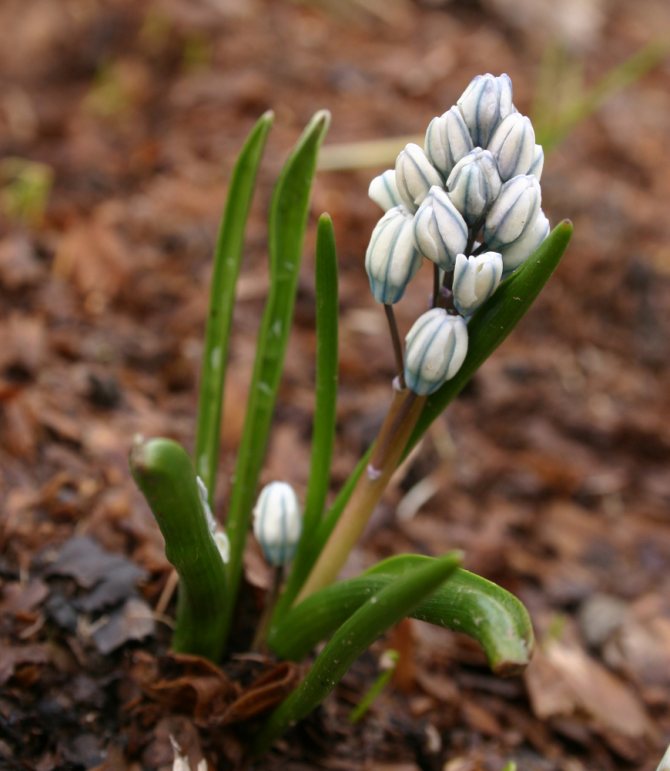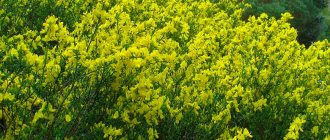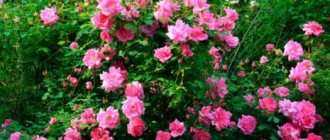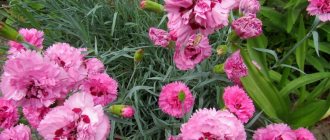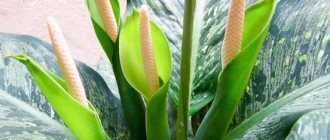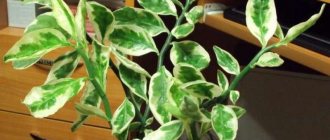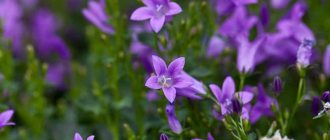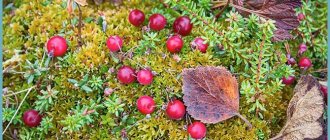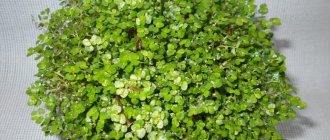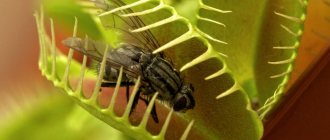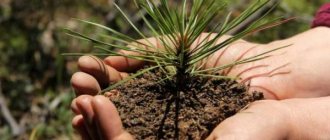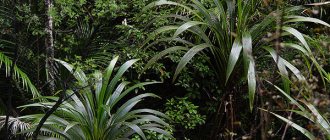The plant Pushkinia (Puschkinia) is a representative of the genus of the subfamily hyacinths, of the asparagus family, but in some sources such a flower is included in the lily family. This flower was named after Musin-Pushkin, who was a Russian mineralogist and chemist, as well as a member of the Royal Society of London, it was he who first collected data from the flora on Ararat. Pushkinia is also sometimes called the dwarf hyacinth, because these plants are very similar in appearance, as they are the closest relatives. This genus unites only 2 species and several varieties. In nature, they can be found in Asia Minor and Asia Minor, as well as in the Caucasus, while Pushkinia prefers to grow in mountain meadows, among bushes and on damp rocky slopes.
Biological description
Perennial herbaceous bulbous plant [2]. Life form (according to Raunkier): bulbous geophyte [3]. Bulbs are round or ovoid, up to 3 cm long and up to 2.5 cm in diameter. Leaves are linear, up to 15 cm long and 1 cm wide, squat, appear simultaneously with inflorescences [2].
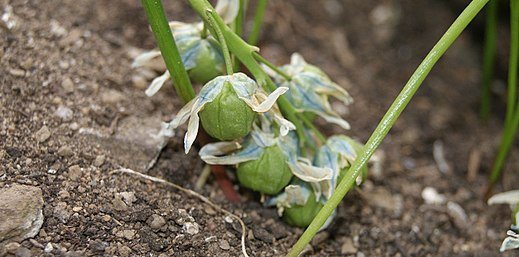
Unripe fruits close up
Flowers usually from one to six, sometimes up to 18, they are collected in a racemose inflorescence. The perianth is simple, corolla-shaped, bell-shaped, consists of six lobes, fused at the base into a short tube. On the inner side of the perianth, the outgrowths of the lobes form a six-toothed crown. The column is short, with a capitate stigma [2].
The fruit is a fleshy capsule. The seeds are almost round [2].
The number of chromosomes: = 10, 16 [2].
Pushkinia after flowering
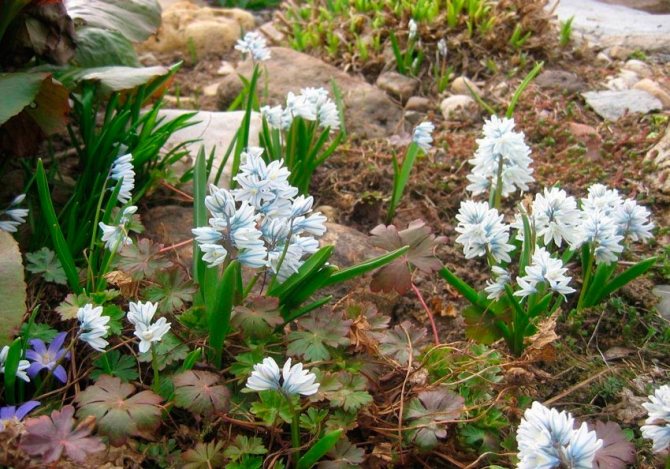

In autumn, after sowing seeds or planting bulbs in open soil, a dormant period is observed in Pushkinia. At this time, the plant should be prepared for wintering; for this, the site is covered with humus (layer thickness from 20 to 30 mm) or peat (layer thickness from 50 to 70 mm). In spring or summer time, it is not necessary to remove mulch from the site, because it protects the plants from the rapid growth of weeds and from drying out.
Cultivation, use
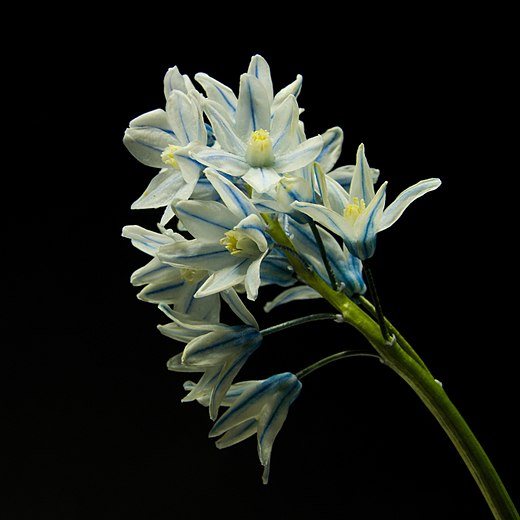

Inflorescence close-up
Pushkinia proleskovidnaya is a valuable ornamental plant. It is used for planting on ridges and borders, often the plant is planted in large spots - both in open spaces and next to large objects (trees, shrubs). It is also used for planting in rock gardens [2].
Agrotechnics
The plant prefers well-drained fertile soil. Grows best in areas open to the sun [2].
Reproduction - both bulbs and seeds. When planting seeds, plants bloom in the third or fourth year. A plant transplant is required after 5-7 years of staying in one place [2].
Planting Pushkinia in open ground
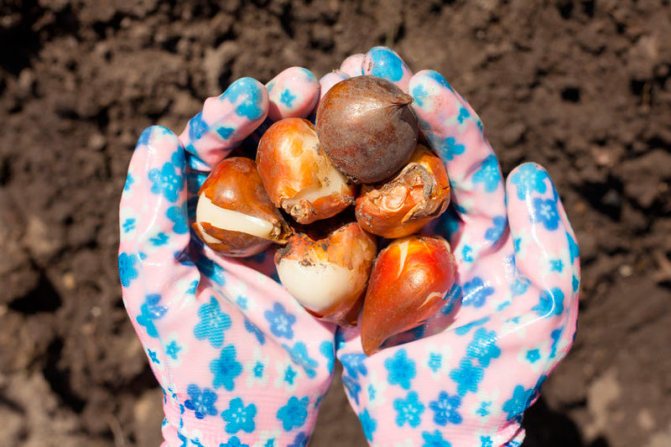

What time to sow
If you decide to grow such a primrose from seeds, then you should be patient. The fact is that when propagated by the seed method, Pushkin begins to bloom only in the fourth year of life. Even the first seedlings appear about 30 days after sowing. But the vegetative breeding method is also ineffective. Seeds are sown in open soil immediately after harvest, and this time, as a rule, falls in June.Sowing can also be carried out from the second half of September to the twenties of October, but in this case, freshly harvested seeds will need to be placed on the refrigerator shelf before sowing, and care should be taken to ensure that they do not dry out.
Seeding features
If the seeds are sown over the winter, then they will be able to undergo a full-fledged natural stratification, and this has a very good effect on the growth, development and health of the plant. But before you start sowing, you need to prepare the site. To do this, care must be taken to ensure that there is good drainage, in the event that the soil is too dense, sand, peat or leaf humus are added to it to loosen it. For sowing, you can choose a well-lit or slightly shaded area. It is necessary to deepen the seeds into the soil by at least 5 centimeters, then for the winter the surface of the site should be covered with a layer of mulch (peat).
Taxonomy, taxonomy
The first valid description of the species was published by the Russian botanist and zoologist Mikhail Ivanovich Adams in 1805 in volume XIV of the organ of the Imperial Academy of Sciences Nova acta Academiae scientiarum imperialis petropolitanae
[3] [4]. According to the Linnaean system used by Adams in this publication, the species was classified as class VI (
Hexandria
, Six-lined), order
Monogynia
[4].
Synonyms
Pushkinia plants with a relatively long funnel-shaped perianth tube were previously considered as a species of Puschkinia hyacinthoides Baker (for example, in the 4th volume of "Flora of the USSR", published in 1935 [5]), later such plants were no longer isolated as an independent species, and its name was synonymous with the species Puschkinia scilloides
[6]. Plants of Pushkinia scilloides, which differed in larger flowers and sharply two-toothed crown lobes, were previously considered as a variety of Puschkinia scilloides var. libanotica (Zucc.) Boiss. [2], but later this name was also reduced to synonyms of the species [6].
According to database information The plant list
(2013), the synonyms of the species include the following names [6]:
- Adamsia scilloides (Adams) Willd.
- Puschkinia hyacinthoides Baker
- Puschkinia libanotica Zucc.
- Puschkinia scilloides var. libanotica (Zucc.) Boiss.
- Puschkinia sicula Van Houtte
Description of Pushkinia flowers and their photos
This variety is very close to Scylla and Chionodox, but differs in a crown consisting of stamens and ovaries. They can be up to 15 centimeters long and are available from January to mid-March.
Description of Pushkinia flowers deserves special attention, since this garden culture is able to revive any landscape design.
Look at the photo of Pushkinia flowers - these adorable creatures attract attention with their tenderness and purity:
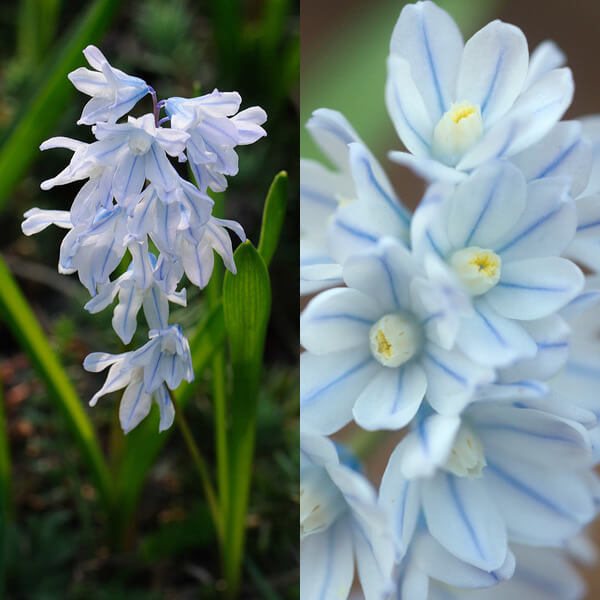

The leaves of the belt-shaped flower grow in pairs and have a rich green hue. They begin to bloom in early spring in the form of inflorescences up to 25 centimeters in height.
They bloom together with thorns, flowers in the shape of a star with blue or white stripes. The first petals appear on the plant in late winter or early spring. They have very loose buds and a wonderful, mesmerizing aroma.
The seeds are housed in three separate capsules. After the seeds ripen at the very beginning of summer, the plants remain dormant until next spring.
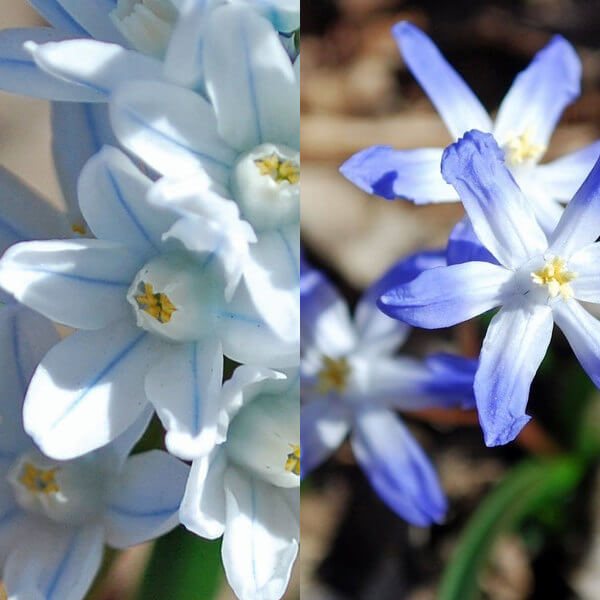

Like all representatives of the genus Chionodox, the bases of the stamens in Pushkinia plants are flattened and closely grouped in the very center of the flower. In the corresponding representatives of the genus Scylla, the stamens are not flattened or grouped together.
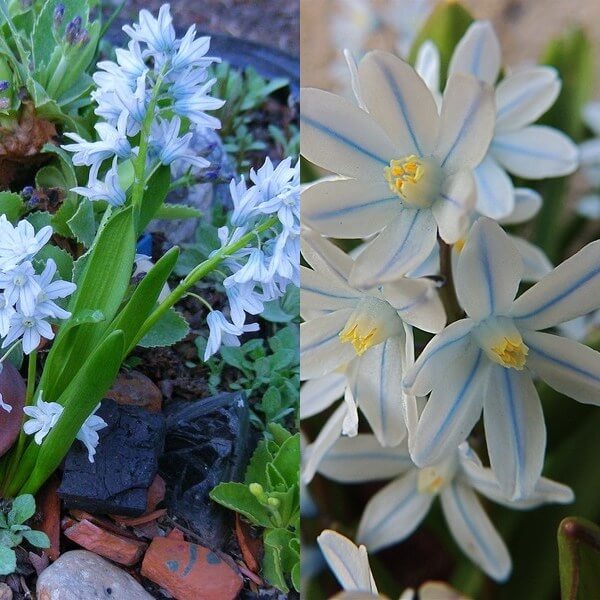

Forcing Pushkin
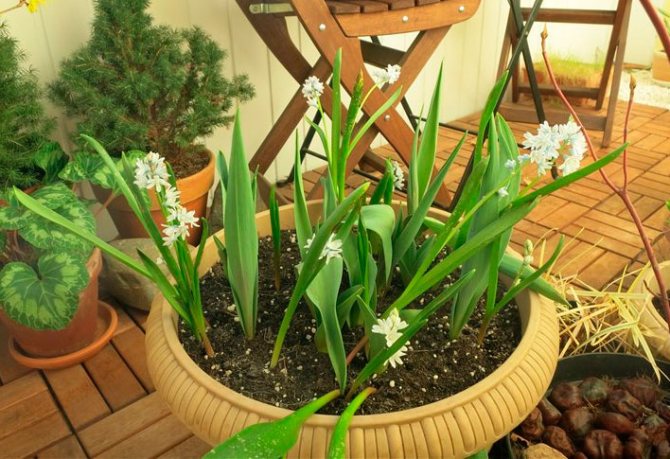

Pushkinia is perfect for forcing indoors, and its beautiful flowers can be seen already in winter. Several bulbs are selected for distillation. They are planted in November in a pot with a diameter of 13 to 15 centimeters and a height of about 7 centimeters. A soil mixture is poured into it, which includes leaf humus, river sand and sod land, taken in a ratio of 1: 1: 2. The container is removed for 8-10 weeks in a dark basement, where the air temperature should not exceed 10 degrees, and the humidity should be about 85-90 percent. Then she is taken out into a well-lit room, in which it should not be warmer than 15 degrees, and the flower will need to be watered. Flowering begins after 14–20 days.It is recommended not to throw out the faded bulb, because if you take care of it correctly, it will delight you with its spectacular flowers again and again.
- Protologue: Adams M. F.
Descriptio novi plantarum generis: [lat.] // Nova acta Academiae scientiarum imperialis petropolitanae. - 1805. - Vol. XIV (23 Ianuarii). - S. 164-166.
Pushkin care in the garden
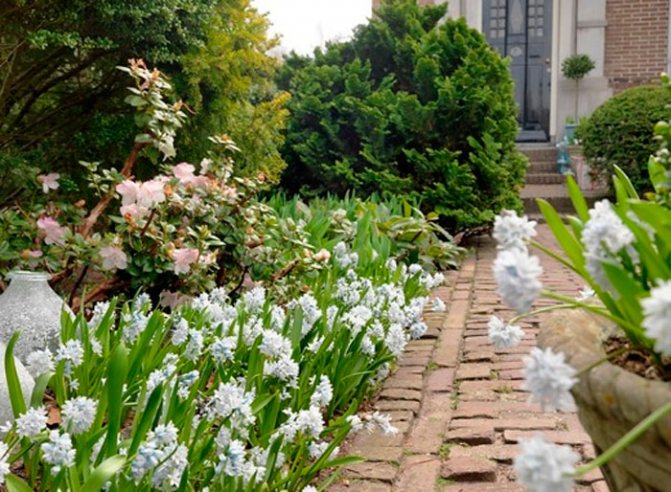

You need to take care of Pushkinia in the same way as for other flowers growing in the garden. So, it needs to be systematically watered, loosened the surface of the soil, remove weeds, feed it in time, and also remove the inflorescences that have begun to wither in a timely manner. To significantly reduce the number of watering, weeding and loosening, it is necessary to cover the surface of the site with a layer of mulch (peat). In order for these flowers to develop normally and have a very effective appearance, you need to take care of them correctly and systematically, for example, if the weed is not removed in time, it will quickly "crush" the fragile little push.
Top dressing is done in early spring. To do this, use a complete mineral fertilizer (for example, nitrophoska), which is evenly distributed over the surface of the site, taking from 50 to 60 grams of substance per 1 square meter (about a couple of handfuls). In this case, top dressing must be done even if there is snow. After the soil thaws in April and shoots appear, it will be necessary to loosen the aisles.
If the spring is dry, then pushkinia will need to be watered, while it should be borne in mind that it especially needs watering during the period of intensive growth of leaf plates. In summer, it is imperative to carry out timely weeding and loosening of row spacings. In the event that the bush has turned yellow earlier than it should be, or it is affected by a disease, it must be dug up and must be destroyed.
It is quite simple to grow Pushkinia, while it will surely give you a lot of pleasure during flowering in the spring.
Reproduction of Pushkinia
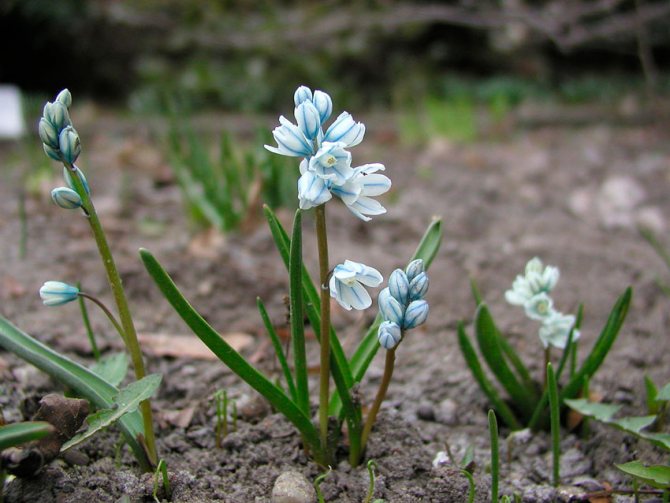

Growing Pushkin, one must remember that it needs systematic transplants. The fact is that an adult bulb grows up about 5-7 children of various ages within 4–5 years. These plants become very crowded, from which their decorative effect is significantly reduced. During transplantation, the children must be separated from the mother's bulb. Thus, the vegetative reproduction of Pushkinia occurs. How to propagate it in a generative (seed) way is described above. The nest of bulbs must be dug up and the babies must be separated from the parent bulb. Then they are removed for storage, and with the onset of the autumn period they are planted in a permanent place, while a distance of at least 10 centimeters must be kept between the bulbs. Experts recommend dividing the bulbs once every 5 or 6 years.
It should be remembered that it is necessary to dig up the bulbs on time. Bulbs dug out ahead of schedule are very poorly stored. If they are removed from the soil later than the due date, then most of the children will remain in the ground, since at this time they are extremely easily broken off from the mother's bulb. The time when you should start digging a bush is determined by the state of its leaves. As soon as they dry up, you should start transplanting and dividing. The bulbs must be removed from the soil and put in the shade to dry, and then the remnants of the earth and old roots must be removed from them. Separated babies should be sorted by size. Large bulbs can be planted in open soil in a permanent location or used for forcing indoors. Small bulbs need to be planted in a training bed for growing. All sorted bulbs should be placed in slightly damp sawdust or peat and stored in a well-ventilated cool room. There they should be stored until planting.
Pushkinia is planted in open ground in the autumn. The planting depth depends on the size of the bulb and can vary from 5 to 7 centimeters, while a distance of at least 10 centimeters must be maintained between the holes.
Such a flower is able to reproduce well enough by self-seeding. This method of reproduction of Pushkinia is an excellent alternative to seed, the main thing is that one must not forget to control this process.
Pests and diseases
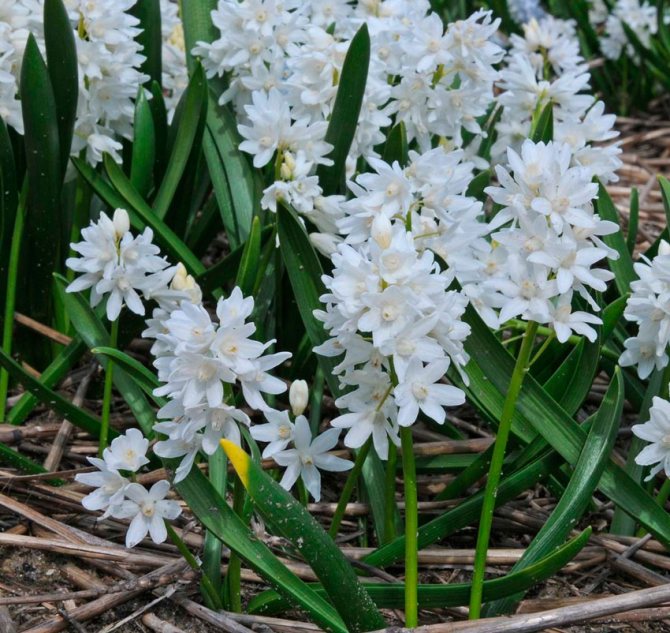

This plant can suffer from those diseases that affect small-bulb and bulbous plants. For example, if spots of brown color appear on the ground parts of the bush, this means that it is affected by gray rot, the causative agent of which is the fungus Botrytis. This is a rather dangerous disease, because this fungus is omnivorous, and it can quickly infect other plants. As a preventive measure, experts recommend, watering the bush, to try to prevent the liquid from falling on the surface of the foliage, not to overfeed the gun with nitrogen, and also to dig up and destroy the affected specimens as soon as possible. At the initial stage of the development of the disease, such means as: Champion, Bordeaux liquid, Topaz or Cuproxat are used to destroy it. If the specimen is very badly affected, then Skor, Previkur or Fundazol are used to process it.
It is also quite dangerous that the plant is damaged by bulb rot, while the causative agent of such diseases is a variety of fungi. In infected bushes, the base of the leaf plates turns yellow, then the disease penetrates into the bulb itself, from which specks of a brownish-red color are formed on its surface. This leads to the death of the bulb. This infection can persist in the soil for a long time. In order to save the plant, it must be treated in a timely manner with a product containing copper. Before planting an onion, it must be carefully examined, if it raises the slightest doubt, then it is better to destroy it.
Pushkinia is also susceptible to a disease such as achelenchoides. Because of it, the scales of the onions turn brown, ring rot appears. Also, near the bottom on the surface of the bulb, pale brown necrotic specks are formed. In the affected bush, there is a lag in development and a loss of decorative appearance. All diseased bulbs must be burned, and before planting healthy ones, they are immersed for a while in slightly hot (about 43 degrees) water.
The bulbs of the plant can damage the mice, in order to drive them away, bait with poison is laid out on the site. Also, the danger for such a flower is represented by root meadow mites, which penetrate into the bulbs, gnawing their bottom. They eat up the inner scales, which causes the bulbs to rot or dry out. For preventive purposes, the bulbs should be treated with insecticidal preparations before planting. If there is a serious risk of infection, then the pushkin is treated with the same drugs on the site.
How to properly care for a plant
Caring for a representative of the asparagus family does not require much effort and knowledge. All actions are simple: daily moistening of the soil, loosening the soil, pulling out weeds, periodic feeding and removing dead inflorescences.
- If there is no time for constant maintenance of moisture, then it is worth using a trick - cover the surface of the earth with a small layer of mulch.
- It is worth taking seriously the care processes and monitoring the growth of grass, which can disrupt the process of flower growth.
- Provide complementary foods for the first time spring days. As a top dressing, mineral fertilizers are used, which should be distributed in the open field in an even layer. Complementary feeding should not be disturbed even in case of precipitation.
- After thawing a plot of land and the appearance of the first shoots, it is necessary to provide the soil with oxygen by loosening it.
- Any varieties of Pushkinia must be provided with sufficient moisture if spring days are scarce in precipitation.
- The warm season requires careful weeding and loosening of the soil between the rows of flowers.
- If a change in the appearance of the plant was noticed, for example, it turned yellow, began to die, then it must be urgently dug up. The land where the diseased plant grew is cultivated, and the bulbs are burned.
An adult plant will delight any summer resident and grower with its beauty and unusual appearance.
Where and how it grows
Pushkinia can be found in arid and rocky areas. It is most often found in the Caucasus and Asia Minor. Pushkinia blooms around April, just after the snow melts. Inflorescences bloom from about ten days to three weeks.
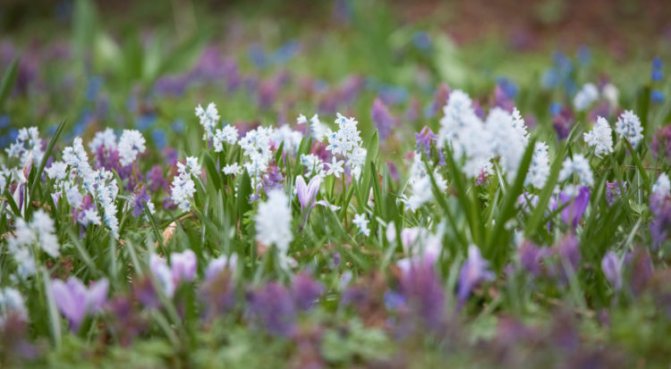

Pushkinia is a perennial plant that spends most of its life in a dormant state. In this it is similar to Chionodox, Galanthus and Camassia. Plants with this life cycle are called ephemeroids. The plant itself is picky, and grows calmly in rock gardens and rockeries, landscape parks and wild gardens. Due to the fact that Pushkinia is quite small in size, it is ideal for home growing in a garden or pots.
Popular varieties
Among a large number of varieties, the following are popular.
Alba
One of the rare varieties of Lebanese Pushkin is called Alba. Its distinctive features are its snow-white color and the presence of an expressive blue line on the vein of the petal. The inflorescences are oval, and the leaves are thin, linear.
Libanotics
Another subspecies of Lebanese Pushkin is Libanotics. This plant attracts attention with large flowers of a beautiful blue hue.
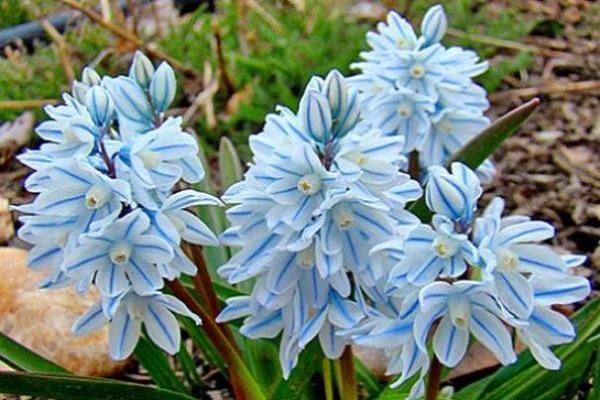

Diseases and pests
Pushkin flower is susceptible to such dangerous diseases as gray rot and fungal infection. Signs of gray rot appear in the form of the formation of darkening on the leaves and stems of the plant. The cause of the disease is the omnivorous fungus Botrytis, which is able to move from diseased bushes and infect healthy flowers with spores.
As a preventive measure, it is recommended to water the plant at the root, avoiding drops of water falling on the leaves. Excessive application of nitrogen fertilizers also negatively affects the growth and development of Pushkinia. To stop the spread of the fungus, the bushes are treated with the following chemicals: Topaz, Champion, Cuproxat or Bordeaux liquid. In exceptional cases, when most of all perennial plantings are infected, Fundazol and Previkura solutions are used for treatment.
Flower bulbs also suffer from rot. If the disease is started, the leaves of the flower will begin to turn yellow, and the peel of the bulbs will be covered with brownish-brown spots. Fungal spores can enter the soil. In the fight against fungi, drugs containing copper are used. It is recommended to choose the healthiest bulbs for planting.
Achelenchoides is a type of bulbous disease in which the scales change color and rot over time. Bulbs with obvious signs of disease must be destroyed. A healthy-looking planting material should be soaked in hot water before being sent to the garden.
Pushkin flowers attract mice. The baits placed on the site scare away rodents. In addition to them, the bulbs are eaten by meadow mites, which feed on juicy scales. This will not happen if you treat them with insecticidal products.
Landscape combinations
Graceful Pushkinia looks harmoniously in the foreground in tandem with other primroses. For spring gardening of flower beds, it is often used by landscape designers. Perfect companions for her in group plantings are:
- dwarf irises;
- chionodox;
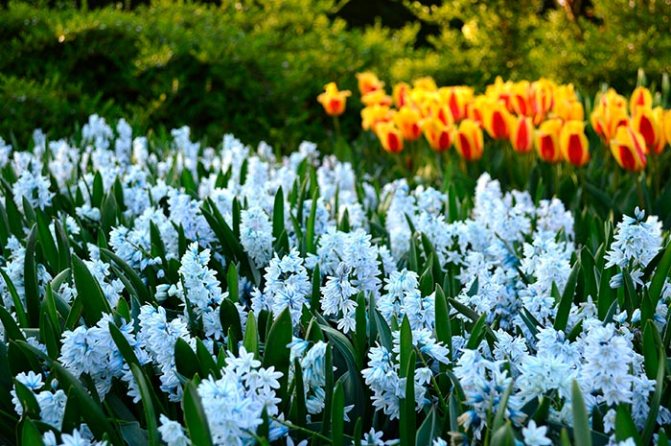

- crocuses;
- woodlands;
- muscari.
Delicate white, azure, sky-bluish tones of Puschkinia will decorate summer cottages, alpine slides, borders along paths, colorful spring mixborders. It is advisable to plant it next to perennials that bloom in May. After the bulbous culture has faded, they will fill the empty areas with bright colors. Plants look beautiful against the background of coniferous crops, in the near-trunk circles of shrubs or trees: they will become colorful accents of a still empty garden.
Enchanting Pushkinia, forming a wonderful blooming carpet, are an adornment of spring flower beds, symbolizing the long-awaited arrival of warm days.
Reproduction
For reproduction, seeds or daughter bulbs of the plant are used.
Seeds
Seeds for propagation of Pushkinia are harvested at the end of the flowering period. They must be dried in the fresh air and stored until autumn in a cool, dark place. Planting into the ground is carried out at a depth of at least 5 cm, at a similar distance from each other, so that the plants can grow and develop freely.
Bulbs
The bulbs are harvested from Pushkinia, which has reached the 4-5th anniversary. This is done after flowering, usually in the middle of summer. For planting, beautiful, healthy specimens are selected without damage and signs of disease. All material must be dried and stored in a cool and dark place.
Pushkinia bulbs are planted to a depth of 7 cm.The distance between the holes is 10 cm.
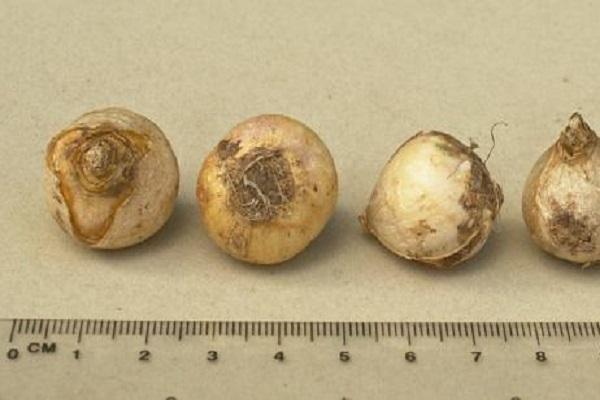

Harm and contraindications
As such, there are no contraindications to planting a pushkin. However, for allergy sufferers who often react to inflorescences, pushkinia will be harmful. Therefore, before planting this plant, pay attention to how you react to it.
In order to conduct the test, you can purchase a potted Pushkinia flower and put it in your room. It is better to do this during the period when the flower begins to bloom. If the reaction does not appear within two days, everything is in order and you can keep this plant with you or even grow it in your garden.
Pushkin varieties and their photos
Today, Pushkinia varieties are represented by several types of this plant, suitable for landscaping household plots and landscape designs. On this page further you can see the varieties of cannon with photos and brief descriptions of botanical characteristics.
Lebanese Pushkin or Libanotic Pushkin
Lebanese Pushkinia is a spring flower of the family. Its height is no different from other species - no more than 20 centimeters in length. She begins to bloom earlier than other varieties of Pushkinia - from April to the end of May.
The difference between the Lebanese species and the main one is the sharp two-toothed crowns and larger flowers (compared to the main species). Since it blooms very early, then in garden compositions they are used with their own kind - as large spots in a flower garden, as a living border, etc.
Not the brightest colors of pushkinia libanotika will look great against the background of rockery. If you have little space and there is no way to create a flower arrangement from previously blooming ones, then you can also combine them with perennials - they will look quite harmonious together.
Also, spots of white and blue color will be a wonderful spring decoration for any mixborder - they can set off or emphasize the idea of your flower garden.
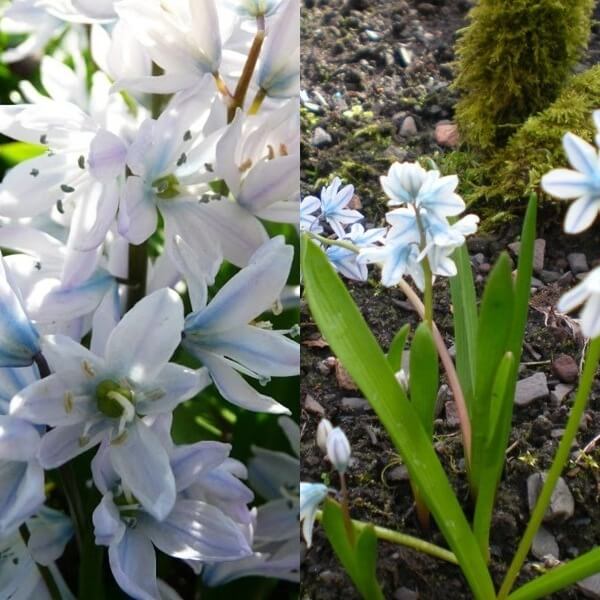

Pushkinia alba
Alba Pushkin is a type of Lebanese Pushkin (or Libanotic Pushkin). This is a very rare species with snow-white flowers and a blue line along the vein.
In general, the plant is unpretentious and grows well both in the sun and in partial shade. The bulbs of the variety reach two centimeters in diameter. Leaves up to one centimeter wide and 15 centimeters long are linear.
The inflorescences are collected in the form of an oval and contain 12-15, and sometimes 30 drooping flowers. On one bulb, there are from two to four peduncles.


Natalia
Hello everyone, my name is Natasha! I love plants and decor. I make florariums, collect a collection of plants, maintain a pharmacy "vegetable garden", and also maintain a blog lovgarden for everyone who is passionate about the theme of the garden, vegetable garden and plants as much as I am.
Landing site preparation
The composition of the soil does not really matter, but the primrose cannot fail to respond to chernozem soils with good drainage with larger inflorescences. As for most bulbous plants, excessive moisture is undesirable for the root system.
Planting and leaving Pushkinia - video
Important!!
When preparing a site for planting Pushkinia, special attention is paid to removing weeds, otherwise they can cause significant harm to the future group of primrose.
Mulching will help fight weeds in the future. Adult plants require feeding in early spring. For these purposes, nitroammophoska is suitable, which can be applied to the ground immediately after the snow cover disappears. If planting allows, then between the shoots, carefully loosening the soil is carried out. Pushkin needs additional watering only during abundant flowering.
Before planting Pushkinia, the soil should be fertilized.
During digging, the soil is cleared of varietal grass, and enriched with the following components (per 5 m2):
- ammonium nitrate - 40-60 gr.;
- superphosphate - 50-70 gr.;
- potassium chloride - 30-50 g.;
- a bucket of humus.
Planting primrose can be done with bulbs or seeds.
A native of the Caucasus - the highlight of spring plantations
The first days of the awakening of nature from winter sleep are marked by the flowering of bulbs. Among them - graceful Pushkinia, attracting decorative white and blue inflorescences. Puschkinia belongs to the subfamily of forest beetles. For the similarity of the inflorescences, it is also called dwarf hyacinth. Miniature bulbous perennial looks spectacular in spring group plantings.
The early flowering culture was named by professor of botany Mikhail Adams in honor of the Russian chemist Count Musin-Pushkin. A miniature bulbous plant was found by scientists during a joint expedition along the mountain slopes of the Caucasus. A representative of the asparagus family will become a decoration of the spring garden, complementing summer cottages, rockeries, rock gardens, rocky hills with blue and white inflorescences.
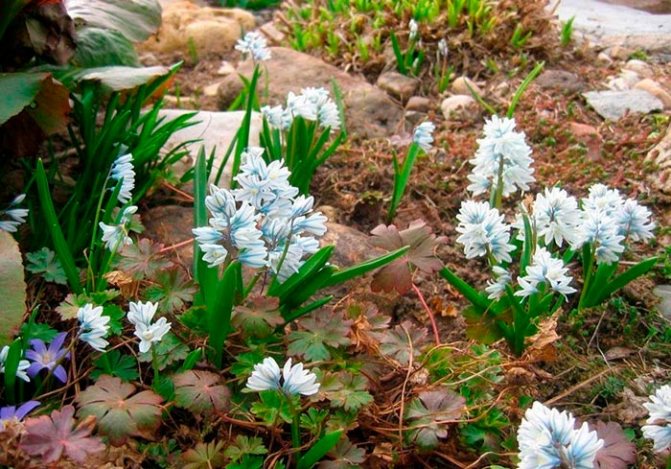

Growing Pushkinia effectively from seeds and bulbs!
Growing Pushkinia from seeds will take a lot of time - gardeners claim that the first flowers appear on it only four years after planting and sowing the seeds. After all, just for the seeds to germinate at least a little, it takes them at least one month.
First, they are sown in containers and kept in an apartment or greenhouse. After a while, they are moved to a cooler place in the shade and near the wall - preference is usually given to windows on the north side, after which the container is covered with glass or polyethylene.
Do not forget to constantly check the moisture level of the ground and do not miss the emergence of seedlings. After the first seedlings are ready, they can be placed on open ground.
However, growing puffinia from seeds is no less effective than from bulbs, since decorative properties are better preserved using this method.
From the bulb, the flower multiplies in the fall, when the foliage has already fallen off. Bulbs are taken from the bush no more than once every two years.
Look further at the photo of Pushkinia grown from seeds by seedlings and from bulbs by dividing them:
Use in landscape design
Pushkinia is very decorative. It looks great in borders in combination with other early flowering plants. You can plant a flower in rockery. You can find out how to make a rockery with your own hands by reading the corresponding article on our website.
If the site is small, you can place the plant in a flower garden with perennials.In mixborders, Pushkinia with Proleskaya and Chionodox look great. Moreover, the presented flowers will reliably protect the dwarf hyacinth from direct sunlight.
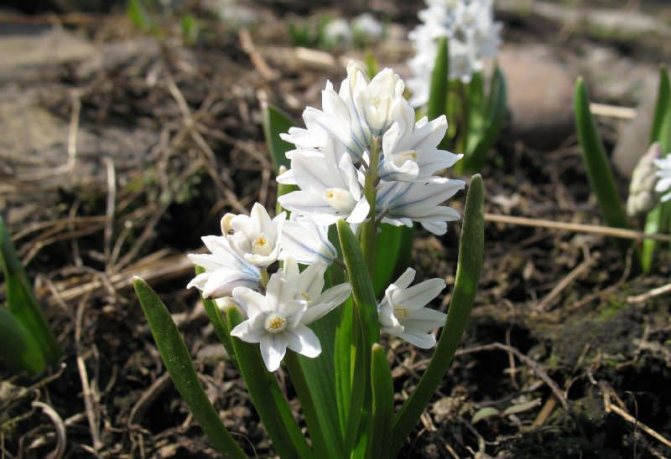

An excellent option is the location of the cannon around the tree trunk circles. In the spring there is no foliage yet, which means that it does not shade the flowers. In the fall, it is important not to damage the gun by digging up the soil near the trees. The plant looks great near the currant. The presented species do not interfere with each other.

